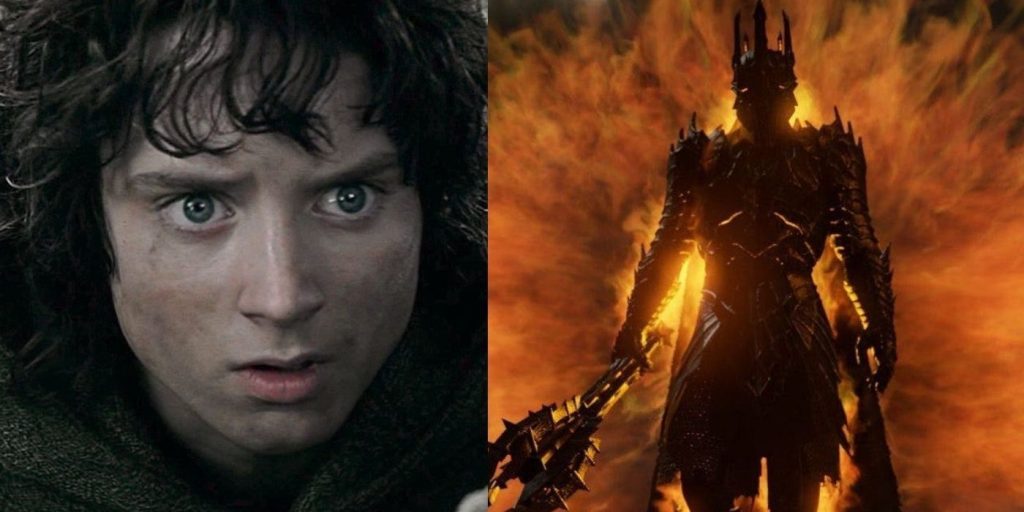Sauron's only words in the entire The Lord of the Rings franchise are "you cannot hide. I see you. There is no life in the void. Only death." Yet he is behind the ever-growing threat that faces all of Middle Earth. In Peter Jackson's trilogy, audiences see Sauron as he was in his physical form (although he is covered in armor from head to toe, and viewers can't see any of his features) in the opening prologue in The Fellowship of the Ring. When he is defeated and killed, his life force is transferred to the Ring. From then on out, Sauron is only seen in the trilogy as an enormous, fiery eye that is suspended in the air on top of a very tall watchtower called Barad-dûr located in Mordor, which is referred to as The Eye of Sauron. It is ever watchful.
This watchtower is also sometimes referred to as the Great Eye or the Dark Tower. Many fans find themselves asking, "wait a minute, is that really Sauron's actual eye?" The Great Eye is very large, lidless, and wreathed in flame. Fans are smart enough to realize that this one, singular eye could not possibly be Sauron's actual eye, because he would have to be a giant made of fire for that to make sense. Viewers are told throughout the trilogy that Sauron cannot yet take physical form. When he was defeated, his spirit was bound to the Ring. Because the Ring survived, so did Sauron. This is much like Voldemort in Harry Potter, whose spirit was alive thanks to the Horcruxes, but he had little strength until he was able to gain his physical form.
RELATED: Why Doesn't Gandalf Use His Magic Or Powers More?
Showing Sauron's metaphorical eye this way was a choice Peter Jackson made for the beloved trilogy. The eye is really just a symbol for how much control Sauron had over Mordor and all things evil, and it was Sauron's will of ultimate power that spread across the lands far and wide as far as the eye could reach. It's basically Sauron's surveillance, but not Sauron himself. He was always "watching," but really watching here means that his omnipotence was always felt. Like Gandalf, Sauron was once a Maia. However, just like Lucifer was a fallen angel, Sauron was considered a fallen Maia. Maiar are shape-shifting beings, and Sauron was once a wolf, serpent, and then vampire before taking on a fair form (similar looking to an Elf or human, though he was neither).
Sauron was able to seduce and convince the Elven smiths of Eregion, led by Celebrimbor, to forge the Rings of Power because he was disguised as Annatar (or Lord of Gifts). The Rings were given to the different races of Middle Earth. But the Elves, being wisest of all, could sense Sauron's treachery, and they took off their Rings and were able to hide them. It was a good call, because Sauron forged in secrecy a last ring, the One Ring, which had power and control over all other Rings and those who wore them. The Ring also gave Sauron ultimate power and strength. The Elves taking off their Rings made Sauron furious, as his goal was to control the powerful Elves and have them on his side.
Sauron maintained this fair form until the Fall of Númenor, after which he was unable to ever take a fair form again. What audiences see in the prologue of The Fellowship of the Ring was Sauron's last physical form—which was a 9-foot tall terrifying being. Isildur took up his father's broken sword, Narsil, and cut the Ring from Sauron's hand. Because most of Sauron's power was stored in the Ring, when he was separated from it, he was left without a body and returned to his spiritual form that latched onto the Ring. The War of the Last Alliance lasted many years, but Sauron was defeated.
J. R. R. Tolkien described the Eye of Sauron in a metaphorical sense, as it was not an actual eye but rather a symbol of Sauron's influence over Middle Earth. Sauron was hunting for the Ring so that he could again take physical form, and the Great Eye was a way to show his relentless search for the Ring. Peter Jackson chose to show Sauron as a fiery, lidless eye so that Sauron would feel more like the present and growing threat that he was. When the Ring was destroyed in The Return of the King, Sauron's power was diminished. The foundation of Barad-dûr crumbled away because the Dark Tower was made with the power of the Ring. When the Ring was destroyed, the foundation of the Dark Tower was destroyed too.
Although Sauron didn't technically die when the Ring was thrown into the fire, he was so weak and lost so much power that he would never again be able to take physical form. Gandalf (in The Lord of the Rings books) said Sauron was now "a mere spirit of malice that gnaws itself in the shadows, but cannot again grow or take shape."
